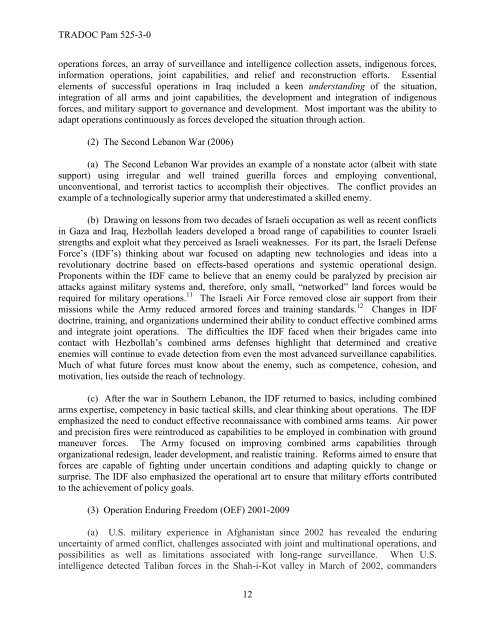(Pam) 525-3-0, The Army Capstone Concept - Federation of ...
(Pam) 525-3-0, The Army Capstone Concept - Federation of ...
(Pam) 525-3-0, The Army Capstone Concept - Federation of ...
You also want an ePaper? Increase the reach of your titles
YUMPU automatically turns print PDFs into web optimized ePapers that Google loves.
TRADOC <strong>Pam</strong> <strong>525</strong>-3-0<br />
operations forces, an array <strong>of</strong> surveillance and intelligence collection assets, indigenous forces,<br />
information operations, joint capabilities, and relief and reconstruction efforts. Essential<br />
elements <strong>of</strong> successful operations in Iraq included a keen understanding <strong>of</strong> the situation,<br />
integration <strong>of</strong> all arms and joint capabilities, the development and integration <strong>of</strong> indigenous<br />
forces, and military support to governance and development. Most important was the ability to<br />
adapt operations continuously as forces developed the situation through action.<br />
(2) <strong>The</strong> Second Lebanon War (2006)<br />
(a) <strong>The</strong> Second Lebanon War provides an example <strong>of</strong> a nonstate actor (albeit with state<br />
support) using irregular and well trained guerilla forces and employing conventional,<br />
unconventional, and terrorist tactics to accomplish their objectives. <strong>The</strong> conflict provides an<br />
example <strong>of</strong> a technologically superior army that underestimated a skilled enemy.<br />
(b) Drawing on lessons from two decades <strong>of</strong> Israeli occupation as well as recent conflicts<br />
in Gaza and Iraq, Hezbollah leaders developed a broad range <strong>of</strong> capabilities to counter Israeli<br />
strengths and exploit what they perceived as Israeli weaknesses. For its part, the Israeli Defense<br />
Force’s (IDF’s) thinking about war focused on adapting new technologies and ideas into a<br />
revolutionary doctrine based on effects-based operations and systemic operational design.<br />
Proponents within the IDF came to believe that an enemy could be paralyzed by precision air<br />
attacks against military systems and, therefore, only small, ―networked‖ land forces would be<br />
required for military operations. 11 <strong>The</strong> Israeli Air Force removed close air support from their<br />
missions while the <strong>Army</strong> reduced armored forces and training standards. 12 Changes in IDF<br />
doctrine, training, and organizations undermined their ability to conduct effective combined arms<br />
and integrate joint operations. <strong>The</strong> difficulties the IDF faced when their brigades came into<br />
contact with Hezbollah’s combined arms defenses highlight that determined and creative<br />
enemies will continue to evade detection from even the most advanced surveillance capabilities.<br />
Much <strong>of</strong> what future forces must know about the enemy, such as competence, cohesion, and<br />
motivation, lies outside the reach <strong>of</strong> technology.<br />
(c) After the war in Southern Lebanon, the IDF returned to basics, including combined<br />
arms expertise, competency in basic tactical skills, and clear thinking about operations. <strong>The</strong> IDF<br />
emphasized the need to conduct effective reconnaissance with combined arms teams. Air power<br />
and precision fires were reintroduced as capabilities to be employed in combination with ground<br />
maneuver forces. <strong>The</strong> <strong>Army</strong> focused on improving combined arms capabilities through<br />
organizational redesign, leader development, and realistic training. Reforms aimed to ensure that<br />
forces are capable <strong>of</strong> fighting under uncertain conditions and adapting quickly to change or<br />
surprise. <strong>The</strong> IDF also emphasized the operational art to ensure that military efforts contributed<br />
to the achievement <strong>of</strong> policy goals.<br />
(3) Operation Enduring Freedom (OEF) 2001-2009<br />
(a) U.S. military experience in Afghanistan since 2002 has revealed the enduring<br />
uncertainty <strong>of</strong> armed conflict, challenges associated with joint and multinational operations, and<br />
possibilities as well as limitations associated with long-range surveillance. When U.S.<br />
intelligence detected Taliban forces in the Shah-i-Kot valley in March <strong>of</strong> 2002, commanders<br />
12
















